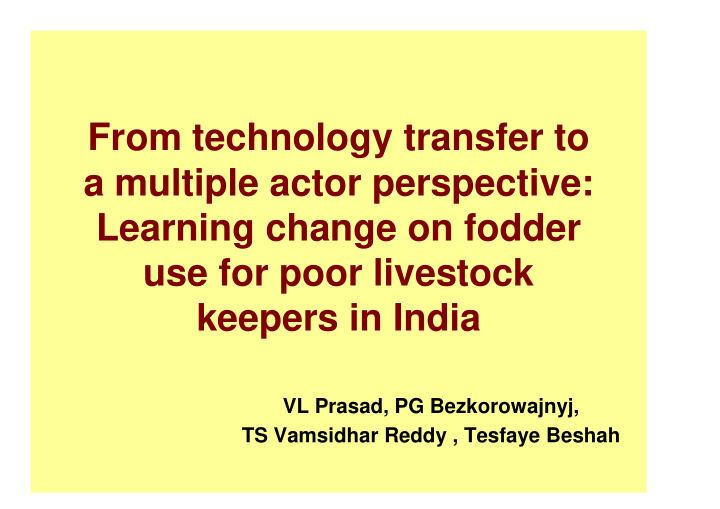



From technology transfer to a multiple actor perspective: Learning change on fodder use for poor livestock keepers in India VL Prasad, PG Bezkorowajnyj, TS Vamsidhar Reddy , Tesfaye Beshah
Paper is about • DFID supported, Enhancing Livelihoods of poor Livestock keepers through increasing use of fodder started in September 2002 in India • Original premise: disseminating new improved varieties of fodder/dual purpose is effective for addressing fodder shortage 2
Back ground Contd……… � However findings from initial key activities shown that addressing fodder shortage was much more complex � Accordingly the Project changed approach from technology transfer to alliance building and finally to a multiple actor and institutional perspective � This paper highlights the learning change and implications for fodder research and Development 3
Project Areas • Country study • Planning workshop • Livestock systems • Project Areas &Partners 4
How the Project evolved (2002 – 06) Stage 1. Project centric and germplasm focused (2002-04) Stage 2. Empowering alliance of Partners (2004-05) Stage 3. Multi stakeholder Perspective (2005-06) 5
Stage 1. Project centric and germplasm focused ( 2003-04) FGD in select villages Project provided improved germplasm of food feed crops Technicians for yield measurements Field days were used as learning platforms 6
however, 03-04 being a drought, limited uptake Partners expertise not used in understanding process Role of partners not formalised 7
Stage 2. Empowering alliance of Partners (2004-05) Technicians were done away with Partners role formalised through mutually agreed LOA Partners trained in process documentation Support studies taken up in Project villages Quarterly action learning workshops for partners 8
alliance of Partners contd……. Focus on germplasm continued specifically on: Groundnut variety (ICGV91114) bred for very low rainfall areas Hybrid maize uptake in low rainfall villages Hybrid napier in irrigated dairy Respective partners have been working on these from 2001 9
alliance of Partners contd…… At the end of this stage it was realized that: The groundnut variety ranked high by the test farmers but scale-up was a problem Hybrid napier, though originally meant for irrigated farmers, scaled up and accessed by other dry land farmers and the landless though lease arrangements Hybrid maize uptake increased by dairy farmers over time though the straw was perceived inferior to sorghum straw 10
Stage 3. Multi stakeholder Perspective (2005-06) Multi-stakeholder workshops separate meetings with different actors Problem analysis from different actors perspective Actor linkage Mapping Actor-factor interactions 11
Lessons for fodder scale-up 1. Unless different actors interact and know each other’s perspectives scale up of technology will not be forthcoming • Test farmers ranked ICGV91114 high • Conflicting priorities between traders and farmers • Small farmers have problems in saving seed • Market regulation week 12
2. New institutions or newer way of working by actors contribute not only to scale up but also ensures that innovation is pro-poor • The Dairy union has been supplying napier to a limited irrigated farmers annually However, many farmers leased out 200 sq mt • areas to other small farmers and the landless • By 2006 June 15000 small farmers and landless have been buying from over 600 ha owned by 3000 large/medium farmers from 374 villages 13
3. When actors link themselves to address self interests win-win linkages become a reality • Napier selling is more profitable than alternative cash crops like cotton and mango • Napier buyers found iit cheaper than concentrate feeds • Dairy collected more milk in the lean season 14
4. Changes at farm level are possible when a series of other changes at farm and higher level like policy, services and service providers happen in situ changes by farmers • Availability of private industry seed at government • outlets from 2003 From 2000 Dairy became autonomous, improved milk • collection network, increased milk prices and supplied subsidized fodder seed • Farmers replaced local buffalos with crossbred cows • Farmers replaced local buffalos with crossbred cows • Cattle breeding services from NGO are paid by the • Cattle breeding services from NGO are paid by the Dairy Dairy • Support price from govt. • Support price from govt. 15
Lessons for Research Design • The phase II of the Project was prepared in 2007 building on these learnings and lessons • The new vision of the project is that in order for pro- poor innovation to take place, the habits and practices of actors involved in innovation need to be addressed. • The project believes that it is possible to facilitate such changes and plans to test ways of doing this using an action research approach. 16
Recommend
More recommend